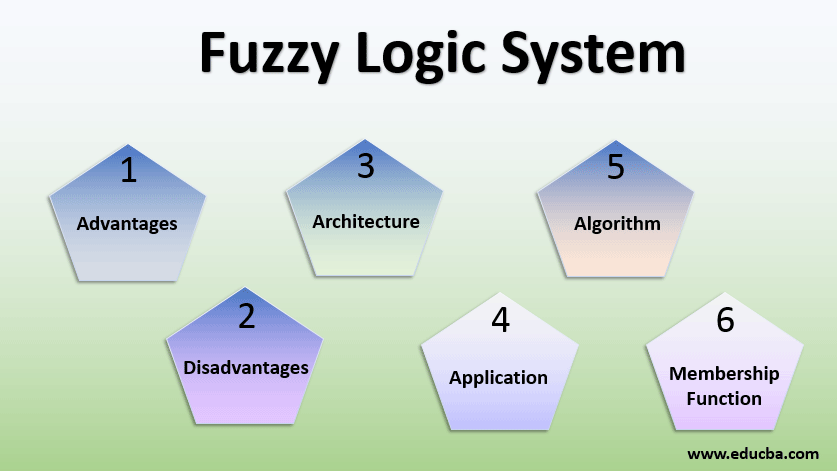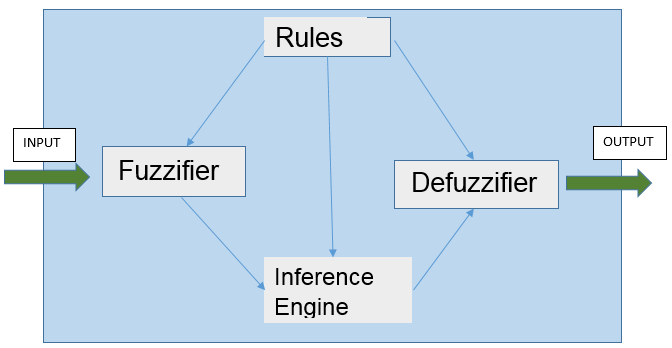
Introduction to Fuzzy Logic System
Fuzzy Logic is a computing approach based on “Degree of Truth” and is not limited to Boolean “true or false.” The term ‘Fuzzy’ means something vague or not very clear. The fuzzy Logic system is applied to scenarios where it is difficult to categorize states as a binary “True or False.” Fuzzy Logic can incorporate intermediate values like partially true and partially false. It can be implemented across a wide range of devices ranging from small micro-controller to large IT systems. It tries to mimic human-like decision-making, which can incorporate all values in between True and False.
An Architecture of Fuzzy Logic System
The Fuzzy Logic System has four major components, which are explained with the help of the architecture diagram below:

- Rules: Rule Base consists of a large set of rules programmed and fed by experts that govern the Fuzzy System’s decision-making. The rules are sets of “If-Then” statements that decide the event occurrence based on condition.
- Fuzzification: Fuzzification converts raw inputs measured from sensors into fuzzy sets. These converted inputs are passed on to the control system for further processing.
- Inference Engine: It helps in mapping rules to the input dataset and thereby decides which rules are to be applied for a given input. It does so by calculating the % match of the rules for the given input.
- Defuzzification: It is the opposite of Fuzzification. Here fuzzy sets are converted into crisp inputs. These crisp inputs are the output of the Fuzzy Logic System.
Membership Function
The Membership Function defines how input to the Fuzzy System is mapped to values between 0 and 1. Input is usually termed as Universe (U) as it can contain any value. The membership function is defined as:
μ A:X → [0,1].
Here X represents the Universe, and Y represents any value between 0 and 1. The Triangular Membership function is the most commonly used Membership Function. Other Membership function includes Trapezoidal, Gaussian and Singleton.
Why and When to Use Fuzzy Logic?
Fuzzy Logic is especially useful when you want to mimic human-like thinking in a control system. More than accurate reasoning, it focuses on acceptable reasoning, which is very close to how the real world operates. It is designed to deal with uncertainties and is proficient in finding out inferences from the conclusion.
Algorithm of Fuzzy Logic System
- Define all the variables and terms which will be acting as input to the Fuzzy System
- Create Membership Function for the System( As defined above)
- Create Rule-Base, which will be mapped to each input
- Convert normal input into fuzzy input, which is fed to the membership function
- Evaluate the result from the membership function
- Combine all the results obtained from the Individual Ruleset
- Convert the output fuzzy set into Crisp input(Defuzzification)
Application of Fuzzy Logic System
Fuzzy Logic is being adopted across all major industries, but Automotive remains the major adopters. A few of its applications are listed below:
- Nissan is using Fuzzy Logic to control the braking system in case of a hazard. Fuzzy Logic uses inputs like speed, acceleration, momentum to decide on brakes intensity.
- Nissan is also using Fuzzy Logic to control the fuel injection quantity and ignition based on inputs like Engine RPM, Temperature and Load capacity.
- It is used in Satellites and Aircraft for Altitude control.
- Mitsubishi is using Fuzzy Logic to make Elevator Management more efficient by taking passenger traffic as input.
- Nippon Steel uses Fuzzy Logic to decide the proportion in which different cement types should be mixed to make more durable cement.
- Fuzzy Logic finds its application in the chemical industry for managing different processes like pH control, drying process, and distillation process.
- Fuzzy Logic can be combined with Artificial Neural Network (ANN) to mimic how a human brain works. Fuzzy Logic aggregates data and transforms it into more meaningful information, which is used as Fuzzy sets.
Advantages of Fuzzy Logic System
Below are five advantages of the fuzzy logic system:
- Fuzzy Logic can work with any kind of input even if it is unstructured, distorted, imprecise or contain noise.
- Fuzzy Logic Construction is very easy to read and comprehend as it closely mimics the way Human-Mind make the decision.
- Fuzzy Logic’s nuances involve using key math concepts like Set Theory and Probability, which makes it apt to solve all kinds of day-to-day challenges that humanity faces.
- Fuzzy Logic can provide efficient solutions to a very complex problem across different industries.
- Fuzzy Logic System needs a very little amount of data to prepare a robust model. Therefore, it needs only a limited amount of memory for its execution.
Disadvantages of Fuzzy Logic System
Below are the top four disadvantages of the fuzzy logic system:
- There is no standard way to solve a problem through Fuzzy Logic; therefore, different experts may have a different solution to a problem, leading to ambiguity.
- As Fuzzy Logic System works with precise and imprecise data, at times, its accuracy can be compromised.
- Fuzzy Logic System cannot learn from its past mistakes or failures as it doesn’t have self-learning ability like Machine Learning and Neural Network.
- Due to the lack of standardization, there is no one fixed way to find rules and membership functions for the given problem. Therefore, at times it becomes difficult to find exact rules and membership functions for some problems.
Conclusion
Fuzzy Logic provides an alternative way to approach real-world problems in the computing world. It can be easily applied to different applications and control system, which can reap long term benefits. Given its ability to work well with “Degree of Truth”, it opens many doors to modern computing. However, it is not the panacea to all the problems as it has severe limitations when it comes to accuracy and its inability to learn from its failure, as in the case of Machine Learning.
Recommended Articles
This is a guide to the Fuzzy Logic System. Here we discuss why and when to use the fuzzy system, with architecture, application, and last with advantages and disadvantages. You can also go through our other related articles to learn more –


